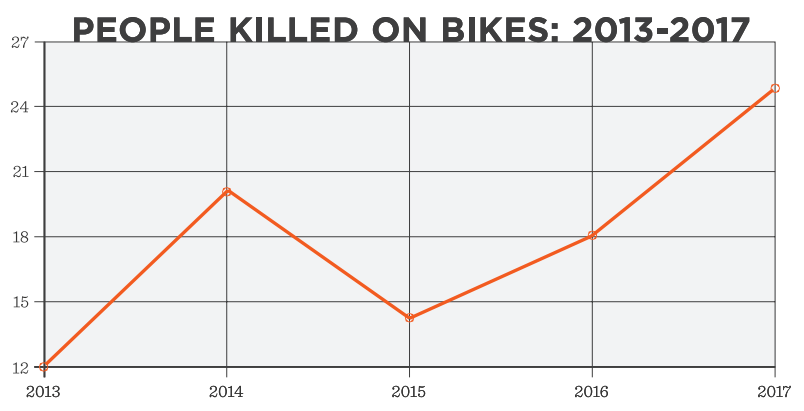To achieve his goal of eliminating traffic fatalities by 2024, Mayor de Blasio must do more to get cars off NYC streets, Transportation Alternatives says in its new Vision Zero report card [PDF]. Congestion pricing, which the mayor opposes, has proven to save lives in other cities and opens up possibilities for street designs that further prevent crashes.
New York has made clear progress on traffic safety under de Blasio. Fatalities are declining, and fewer pedestrians were killed by motorists last year than at any time since record keeping began.
Nevertheless, more than 200 people lost their lives in traffic in 2017, including a larger number of cyclists and motor vehicle occupants than the year before. Total traffic injuries also increased, though up-to-date information on the severity of injuries is not yet available.
The city's Vision Zero timetable calls for the elimination of traffic deaths by 2024. With four years left in office, de Blasio can't leave opportunities on the table. TransAlt says City Hall has to pursue "wholesale changes and bold decisions employed to scale, like exchanging car parking for curbside protected space for cycling, and real efforts to reduce the total number of cars in the city."
In London, one benefit of congestion pricing was a substantial reduction in crashes resulting in fatal and severe injuries, which dropped 25 percent per mile driven within the cordon zone. The rate of fatal or severe injury crashes involving cyclists fell even more -- 69 percent. Reductions in crashes and fatalities were recorded not only within the charging zone but in the areas ringing the outside of the cordon.
The congestion charge has also cleared the way for London to establish more pedestrianized areas and protected bikeways, further improving safety. Citywide, 116 people lost their lives in London traffic crashes in 2016, the last year for which data is available. That's fewer than half the number of traffic deaths in NYC that year and nearly 100 fewer deaths than in 2017, despite London's slightly larger population.
Here in NYC, despite recent progress, 2017 marked the deadliest year for people biking since Mayor de Blasio took office, with 25 fatalities. More than half occurred within a "Vision Zero priority areas" -- streets DOT has identified as especially dangerous. TransAlt calls on the mayor to empower DOT to add protected bike lanes to more of the city's most dangerous streets, expanding the treatments that high-traffic streets like Brooklyn's Fourth Avenue.
In its report card, TransAlt gave de Blasio a B- for his Vision Zero work last year. Subtracting from the mayor's score were his unyielding opposition to congestion pricing, his decisions to dole out 50,000 parking placards, and his crackdown on e-bike delivery workers.
DOT got a B, with TransAlt urging the agency to be less deferential to people who will oppose any repurposing of car space. “The supremacy of safety is not a standard in new projects, and the DOT appears to see their task as rallying community support,” the report says. “Bike lane projects are prioritized not by danger, but how easily they will be approved by community boards.”
NYPD received a C-, the worst grade in the report. TransAlt singles out for demerits the NYPD habits of leaking false or inconclusive information to the press after fatal crashes, and ticketing cyclists at sites where drivers recently struck and killed someone on a bike. Moving forward, TransAlt says the agency must do a better job of tracking injury severity and “begin measuring progress as other agencies do” — with data documenting the relationship between the department’s actions and crashes prevented and lives saved.
The TLC has put genuine effort into preventing driver fatigue, piloting crash avoidance technology, and issuing summonses to TLC-licensed drivers, TransAlt says. But the lack of results bumps its grade down to a B-. The number of TLC-licensed drivers involved in fatal crashes increased in 2017, and the vast majority of for-hire vehicle drivers who have killed New Yorkers retain their TLC licenses.
One highlight of Vision Zero implementation, TransAlt says, is the Department of Citywide Administration Services (DCAS), which manages the city's fleet of non-emergency vehicles. Under de Blasio, DCAS has become a national leader in municipal fleet safety. In 2014, eight people were killed by non-emergency city vehicles. Since then the average has been one fatality per year.





